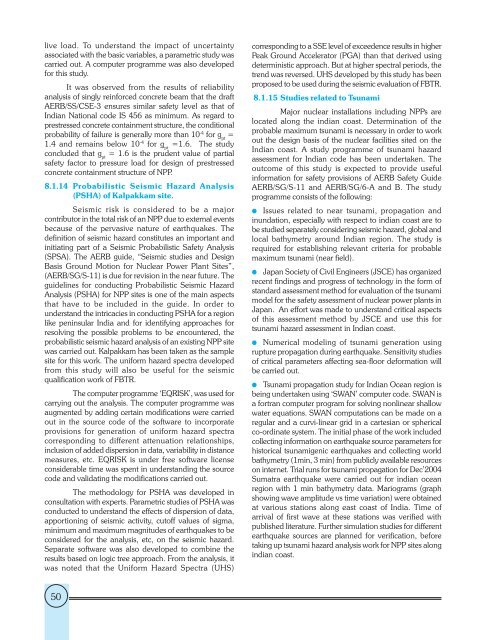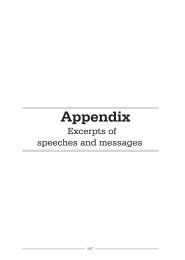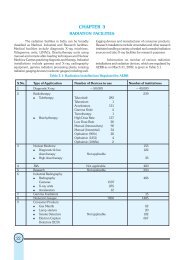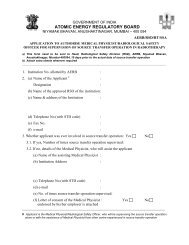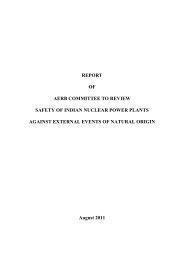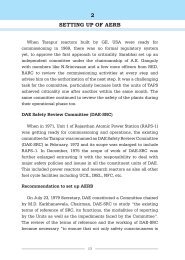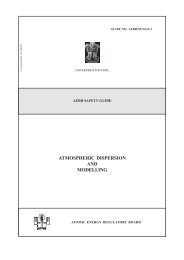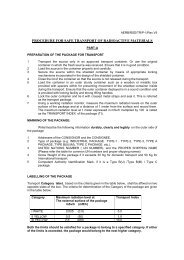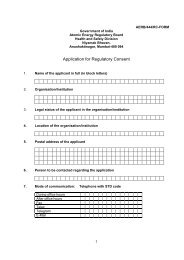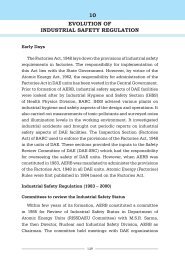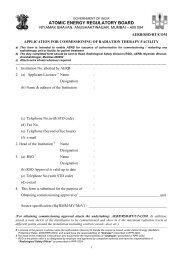here - Atomic Energy Regulatory Board
here - Atomic Energy Regulatory Board
here - Atomic Energy Regulatory Board
You also want an ePaper? Increase the reach of your titles
YUMPU automatically turns print PDFs into web optimized ePapers that Google loves.
live load. To understand the impact of uncertainty<br />
associated with the basic variables, a parametric study was<br />
carried out. A computer programme was also developed<br />
for this study.<br />
It was observed from the results of reliability<br />
analysis of singly reinforced concrete beam that the draft<br />
AERB/SS/CSE-3 ensures similar safety level as that of<br />
Indian National code IS 456 as minimum. As regard to<br />
prestressed concrete containment structure, the conditional<br />
probability of failure is generally more than 10 -4 for g pt<br />
=<br />
1.4 and remains below 10 -4 for g pt<br />
=1.6. The study<br />
concluded that g pt<br />
= 1.6 is the prudent value of partial<br />
safety factor to pressure load for design of prestressed<br />
concrete containment structure of NPP.<br />
8.1.14 Probabilistic Seismic Hazard Analysis<br />
(PSHA) of Kalpakkam site.<br />
Seismic risk is considered to be a major<br />
contributor in the total risk of an NPP due to external events<br />
because of the pervasive nature of earthquakes. The<br />
definition of seismic hazard constitutes an important and<br />
initiating part of a Seismic Probabilistic Safety Analysis<br />
(SPSA). The AERB guide, “Seismic studies and Design<br />
Basis Ground Motion for Nuclear Power Plant Sites”,<br />
(AERB/SG/S-11) is due for revision in the near future. The<br />
guidelines for conducting Probabilistic Seismic Hazard<br />
Analysis (PSHA) for NPP sites is one of the main aspects<br />
that have to be included in the guide. In order to<br />
understand the intricacies in conducting PSHA for a region<br />
like peninsular India and for identifying approaches for<br />
resolving the possible problems to be encountered, the<br />
probabilistic seismic hazard analysis of an existing NPP site<br />
was carried out. Kalpakkam has been taken as the sample<br />
site for this work. The uniform hazard spectra developed<br />
from this study will also be useful for the seismic<br />
qualification work of FBTR.<br />
The computer programme ‘EQRISK’, was used for<br />
carrying out the analysis. The computer programme was<br />
augmented by adding certain modifications were carried<br />
out in the source code of the software to incorporate<br />
provisions for generation of uniform hazard spectra<br />
corresponding to different attenuation relationships,<br />
inclusion of added dispersion in data, variability in distance<br />
measures, etc. EQRISK is under free software license<br />
considerable time was spent in understanding the source<br />
code and validating the modifications carried out.<br />
The methodology for PSHA was developed in<br />
consultation with experts. Parametric studies of PSHA was<br />
conducted to understand the effects of dispersion of data,<br />
apportioning of seismic activity, cutoff values of sigma,<br />
minimum and maximum magnitudes of earthquakes to be<br />
considered for the analysis, etc, on the seismic hazard.<br />
Separate software was also developed to combine the<br />
results based on logic tree approach. From the analysis, it<br />
was noted that the Uniform Hazard Spectra (UHS)<br />
corresponding to a SSE level of exceedence results in higher<br />
Peak Ground Accelerator (PGA) than that derived using<br />
deterministic approach. But at higher spectral periods, the<br />
trend was reversed. UHS developed by this study has been<br />
proposed to be used during the seismic evaluation of FBTR.<br />
8.1.15 Studies related to Tsunami<br />
Major nuclear installations including NPPs are<br />
located along the indian coast. Determination of the<br />
probable maximum tsunami is necessary in order to work<br />
out the design basis of the nuclear facilities sited on the<br />
Indian coast. A study programme of tsunami hazard<br />
assessment for Indian code has been undertaken. The<br />
outcome of this study is expected to provide useful<br />
information for safety provisions of AERB Safety Guide<br />
AERB/SG/S-11 and AERB/SG/6-A and B. The study<br />
programme consists of the following:<br />
l Issues related to near tsunami, propagation and<br />
inundation, especially with respect to indian coast are to<br />
be studied separately considering seismic hazard, global and<br />
local bathymetry around Indian region. The study is<br />
required for establishing relevant criteria for probable<br />
maximum tsunami (near field).<br />
l Japan Society of Civil Engineers (JSCE) has organized<br />
recent findings and progress of technology in the form of<br />
standard assessment method for evaluation of the tsunami<br />
model for the safety assessment of nuclear power plants in<br />
Japan. An effort was made to understand critical aspects<br />
of this assessment method by JSCE and use this for<br />
tsunami hazard assessment in Indian coast.<br />
l Numerical modeling of tsunami generation using<br />
rupture propagation during earthquake. Sensitivity studies<br />
of critical parameters affecting sea-floor deformation will<br />
be carried out.<br />
l Tsunami propagation study for Indian Ocean region is<br />
being undertaken using ‘SWAN’ computer code. SWAN is<br />
a fortran computer program for solving nonlinear shallow<br />
water equations. SWAN computations can be made on a<br />
regular and a curvi-linear grid in a cartesian or spherical<br />
co-ordinate system. The initial phase of the work included<br />
collecting information on earthquake source parameters for<br />
historical tsunamigenic earthquakes and collecting world<br />
bathymetry (1min, 3 min) from publicly available resources<br />
on internet. Trial runs for tsunami propagation for Dec’2004<br />
Sumatra earthquake were carried out for indian ocean<br />
region with 1 min bathymetry data. Mariograms (graph<br />
showing wave amplitude vs time variation) were obtained<br />
at various stations along east coast of India. Time of<br />
arrival of first wave at these stations was verified with<br />
published literature. Further simulation studies for different<br />
earthquake sources are planned for verification, before<br />
taking up tsunami hazard analysis work for NPP sites along<br />
indian coast.<br />
50


